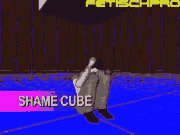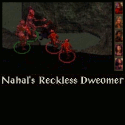|
Yeah, I wouldn't call Dungeon World very "GM May I". As I see it the complaints about "GM May I" are that certain classes (like Fighters) have to rely heavily on "GM may I" to ever do anything cool outside of combat, and spellcasters have explicit rules that say "You get to do cool things A, B, and C in combat and cool things X, Y, and Z outside of combat, plus whatever you can talk the GM into" I mean I still don't personally enjoy DW that much because I strongly prefer the crunchy structured combat giving the GM a break from having to make sure everyone gets their share of the spotlight, by having the rules take over that responsibility for the part where people generally care the most about getting to contribute.
|
|
|
|

|
| # ? May 28, 2024 05:28 |
|
Scyther posted:Yeah, I wouldn't call Dungeon World very "GM May I". As I see it the complaints about "GM May I" are that certain classes (like Fighters) have to rely heavily on "GM may I" to ever do anything cool outside of combat, and spellcasters have explicit rules that say "You get to do cool things A, B, and C in combat and cool things X, Y, and Z outside of combat, plus whatever you can talk the GM into" Like, most PbtA playbook moves are expressly written from the perspective that the player is declaring their intent to do something rather than having to ask permission. When you do a thing, roll Stat is how it generally goes. Now the fiction has to come first, if you want to do a thing that lets you cleave your enemies in twain but your enemy is standing on a tiny rock pillar way out in the distance pelting you with bolts of magical fire then you first have to make your way over to them, which the GM will probably ask how you plan to do so, which you'll then tell them your plan and make an appropriate roll or two, and so on and so forth. What Dungeon World, and most other PbtA books, don't do is try to give you a laundry list of Lego-brick rules that you're supposed to use to determine the proper penalties for sledding down a staircase on a shield or swinging from a chandelier with a main gauche held between your teeth or the various hardnesses of door materials...or in some cases, not provide any guidelines for any sort of thing like that at all and expect the GM to simply ad-hoc everything on the spot after a negotiation about how unrealistic swinging from chandeliers is and anyway I read this one time that knights had to be winched onto their horses so there's no way you could run that far in armor.
|
|
|
|
Harvey Mantaco posted:Yeah. I don't want to go too off the topic of the thread but for a bunch of goons that seems to loathe "GM May I" so much I can't believe this Dungeon World game is so liked. Don't take this as a recommendation. Because if you don't like it you shouldn't play it. But I just wanted to clarify the point. DW isn't so much 'DM may I' as it is, 'DM, what are your amendments'? The DM doesn't really do stuff in DW, the DM reacts to the players. To the point where the DM doesn't take turns, the DM makes moves in response to player activity and at no other times (though 'I have no idea what to do next' is considered a player activity). The elemental role of the DM is to remain passive until the PCs do something so it makes no sense to veto their activity. Whereas in traditional DnD the DM's job is to be the rules master, the narrator, and the world all at once. DW usually asks for the DM to expressly not be the narrator, which removes the 'may I' portion of the equation.
|
|
|
|
No Dungeon world is "GM may I?" as all gently caress but the difference is everybody is on the same page. In something like 5e the fighter has to ask "GM may I?"while the wizard says "I cast..." Dungeon world can also fall into a lot of the same D&D problems with martial/caster if the gm has a magic can do anything and fighters can't mindset moves are a decent buffer but not a guarantee.
|
|
|
|
Dungeon World is 'I am going to Directly Assault [forget the move's proper name] the enemy general by shooting an arrow at the chandelier above him and knocking it down'. D&D is 'Hey DM, can I shoot the chain of that chandelier that you mentioned, to knock it down and try to crush this guy?' Dungeon World is 'I look into the secrets of the universe and call out to the spirits inhabiting the walls to try and find where our guy went' D&D is 'I cast -divination spell-, here's the gold I owe okay i can't do that again today'
|
|
|
|
Magic items that do neat non-numerical stuff are why I enjoy more modern rpg systems. I had a wand in a game that acted as an arcane focus. It looked like a piece of burnt wood, but when you used a spell with it it would glow with embers and make the spell fire-based. The creative aspect came when players used it with non-damaging spells for unique effects. It's so much better than a +X item, which essentially serves more as a QOL upgrade rather than a fun narrative object.
|
|
|
|
It's one of the good parts of Numenera/the Cypher System. The built in, core magic item system supports you having one-off or limited items that do interesting things, but that aren't direct power upgrades.
|
|
|
|
KittyEmpress posted:Dungeon World is 'I am going to Directly Assault [forget the move's proper name] the enemy general by shooting an arrow at the chandelier above him and knocking it down'. Maybe I'm just super new to D&D but I've DMed a few sessions of Out of the Abyss and when I had players ask me if they can do a thing, I just ask them to stop asking and do it. If I mention there's a hanging chandelier, then someone tries to shoot it, hey! if they roll well enough then bam fine. I Guess "Roll well enough" is the same as DM may I, but it's about the rolls. The NPCs followthose rules too. So casters don't have to roll at times, when they do it sucks hardcore when they miss. I've played a fighter in 5E and arguably had the most fun in the party because this game is about more than just hit = fun.
|
|
|
|
Harvey Mantaco posted:I keep seeing people recommend dungeon world as an alternative. I read a thing on it and is the combat as poo poo as it sounds? "Everyone goes whenever they want! Do two things in a row! Whatever!" If it was a more traditional game, the turn order might go something like Jim->Goblin->Bob->Harpy, such that the "saga" of Jim grappling the Harpy plays out 6-seconds and 1-action at a time, with Bob's archery "story" interspersed in-between. Dungeon World instead tells you to let Jim's interaction with the Harpy go on for as many actions/reactions are necessary to either completely resolve it, or until you hit a dramatic cliffhanger where you can "cut-away" the camera to check on how Bob and the Goblin are doing. People are still ultimately waiting to take their turn, it's just that your turn doesn't stop until there's a nice junction for it to do so, rather than the stutter-step of an assassin landing a sneak attack on their target then having to wait another 5 minutes before finding out what happens next. I'd also like to ask what was that thing you read on it, because Dungeon World is maybe second to 4th edition D&D as far as people getting really goddamn salty about it and making disingenuous claims. Harvey Mantaco posted:Yeah. I don't want to go too off the topic of the thread but for a bunch of goons that seems to loathe "GM May I" so much I can't believe this Dungeon World game is so liked. You know how when you're creating an encounter in 3rd edition D&D or in Pathfinder, you have a Challenge Rating for monsters such that you can only really pick from a narrow band in the bestiary? You know how when you fall, there's a specific calculation for falling damage taken per 10 feet fallen? In all of these cases, limits are being placed upon the GM. You can't throw a dragon at the party at level 1 and you can't just unilaterally declare that the player broke their neck and died jumping out of a first-story window. Dungeon World does the same thing. When a Move is triggered, there is a defined thoughtspace as to what the Move can accomplish, including how bad the consequence might be for the player if they Miss and the GM has to introduce a complication. The GM isn't supposed to arbitrarily dick over the players. He can "make something up", but the extent of that something is bounded by the Move. The only difference is that DW does not attempt to define the precise physics of the game world when it places those limits. It doesn't want to say "the dragon has AC 30, therefore you need an attack bonus of +25 before you have a chance of hurting it". Rather, it says "the dragon is loving dangerous, and you're going to need to maneuver past its claws and its tail and find a chink in its thick scales before your sword can find purchase" CaPensiPraxis posted:It's one of the good parts of Numenera/the Cypher System. The built in, core magic item system supports you having one-off or limited items that do interesting things, but that aren't direct power upgrades. The rub, of course, lies in how you have a class that needs those consumables to ever be able to do special tricks, working alongside a class where the consumable simply supplement his own supply.
|
|
|
|
BlueGhostie posted:Maybe I'm just super new to D&D but I've DMed a few sessions of Out of the Abyss and when I had players ask me if they can do a thing, I just ask them to stop asking and do it. This is great, and is the way to become A Good DMtm. The problem isn't that it's impossible to play with that style in DnD but rather that it's possible to play that way with almost any system, and this particular one has no inherent support for (and arguably goes out of its way to impede) that kind of play, where something like DW does(/doesn't).
|
|
|
|
BlueGhostie posted:Maybe I'm just super new to D&D but I've DMed a few sessions of Out of the Abyss and when I had players ask me if they can do a thing, I just ask them to stop asking and do it. The DM making the allowance is only the first part. Adjudication is the second part. First caveat; you might actually be great at doing these. I don't know. But a lot of new DMs aren't. So what happens, because there are no formal rules, is that the DM tries to make decisions based on what 'makes sense' Below 'you' is the speculative 'you'. Here's how that plays out: The fight says he wants to shoot an arrow at the chandelier. You say sure, because you're not a jerk. You decide it's immobile and made of rope, so it wouldn't have a lot of HP, but it's small, so maybe it gets a kind of Dex bonus to AC. You set the AC at 12; that feels pretty low to you. The fighter rolls to hit it. Assuming the Fighter has at least a +5 to hit, he's got to roll a 7 or higher, so there's a more than 25% chance of failure here. So let's say he hits it. The rope snaps and the chandelier falls. But you decide, hey wait a second, if a dragon's breath requires a saving throw, shouldn't a falling chandelier? Enemies in the zone below the chandelier make a Dex save vs a DC of 16. Again, these feels fair to you; the wizard in the party has spell save DC of 15, so this is actually slightly more likely to hit than the wizard's fireball. Okay, so what happens to those who get hit? They go prone, obviously, maybe even require a check to stand up. How much damage do they take? And on and on. As you can see there are multiple chances for this ploy to miss; and if it does, it's worse than the fighter just making an attack roll. It also requires at least four different decisions on the part of the DM, and minimal mistakes. One could easily see a DM imposing redundant checks because it makes sense for the narrative for X, Y, and Z to happen. Other systems simplifying this by reducing it to just the final roll - "roll to make a thing happen in the world, compare results to this chart to see how big of an impact it had." DnD doesn't do that. It often leaves big holes in the rules with little or nothing to fill them, while at the same time giving you enough mechanical widgets where it's hard to handwave stuff.
|
|
|
ritorix posted:Nah, that's why you have a GM handling the pacing. "Ask your GM"
|
|
|
|
|
Drone posted:"Ask your GM" Pacing isn't a mother-may-I situation, with DW its actually flipped around. Usually things start with the GM asking some variation of "X happens, what do you do?" and waiting on the player to tell, rather than ask. But there is a pretty heavy burden on *World GMs due to the constant back-and-forth required by the system's action resolution. A lot moreso than D&D, where the DM just notes down the damage done or replies "the monster fails the save" and things move on.
|
|
|
|
I am new to the whole DM thing but in my groups game I actually encourage the players to get as crazy as they want with trying to describe what they want to do. If someone wants to swing off a chandelier onto a monsters back and make an attack it's just an acrobatics roll and an attack roll. I'm not going to say no just because I can. If there is a chandelier to swing on its because I put it there hoping someone would find some creative way to use it. One of my players is actually playing a flamboyant swashbuckling rogue who I know will do something theatrical in combat every chance he gets, and I love designing for that.
|
|
|
|
wisdomHNOX posted:I am new to the whole DM thing but in my groups game I actually encourage the players to get as crazy as they want with trying to describe what they want to do. If someone wants to swing off a chandelier onto a monsters back and make an attack it's just an acrobatics roll and an attack roll. I'm not going to say no just because I can. This is one roll too many.
|
|
|
|
wisdomHNOX posted:If someone wants to swing off a chandelier onto a monsters back and make an attack it's just an acrobatics roll and an attack roll. The problem here is that a martial class doing something neat is gated by one or more checks before even getting to attack, whereas a spellcaster either rolls once for the spell, or tries to make a monster fail the save, or the spell just takes effect with no contest. In addition, those checks aren't even something unique to the martial attempting them; a wizard (or more likely, bard) with the right stat distribution could do exactly the same thing, and also has a toolkit of spells. Compare to other games, where what you're describing might be called, idk, "Acrobatic Strike: You succeed at any check made to balance or jump as part of this attack." Generic Octopus fucked around with this message at 15:18 on Apr 12, 2016 |
|
|
|
Yeah if anything it should be an attack roll with advantage or something like that. You want to encourage creative use of the environment and cool cinematic stunts, not punish them by requiring more rolls than saying "I attack".
|
|
|
|
Every game should have explicit rules about establishing intent and action and then making the intent a sacred thing that the GM can't gently caress with or require additional rolls.
|
|
|
|
Boing posted:Yeah if anything it should be an attack roll with advantage or something like that. You want to encourage creative use of the environment and cool cinematic stunts, not punish them by requiring more rolls than saying "I attack". I'd probably make it an acrobatics check, rather than an attack roll. That rewards the player's choice to invest in a specific skill (I am making an assumption that the player who wants to play a character that swings from chandeliers signalled that by putting points in the relevant skill though).
|
|
|
|
Boing posted:Yeah if anything it should be an attack roll with advantage or something like that. You want to encourage creative use of the environment and cool cinematic stunts, not punish them by requiring more rolls than saying "I attack". I was actually thinking that as I typed it. At the very least they'd probably get an inspiration because it's in character even if it's not optimal.
|
|
|
|
wisdomHNOX posted:I am new to the whole DM thing but in my groups game I actually encourage the players to get as crazy as they want with trying to describe what they want to do. If someone wants to swing off a chandelier onto a monsters back and make an attack it's just an acrobatics roll and an attack roll. I'm not going to say no just because I can. If there is a chandelier to swing on its because I put it there hoping someone would find some creative way to use it. What doesn't occur to people, because the book doesn't teach them how, is the grasp on dice probabilities to make such actions reasonably doable (reduce it to ONE roll, no matter what) and the grasp on relative scale and thematic action to guide as to what should be possible by the player characters. It trends towards being too difficult, not consistent, and relatively weak compared to a spellcaster's capabilities. Ideally, that's what you're supposed to have rules for.
|
|
|
|
It's also worth noting that other games have things like 13th Age's Swashbuckle, Shadow Walk and Tracker talents. Swashbuckler: quote:Once per battle as a quick action, you can spend your momentum to pull off a daring stunt the likes of which others could scarcely conceive. You may make an attack as part of the stunt, but you'll need to roll normally for the attack. This is an improvisational talent. Shadow Walk: quote:You gain the shadow walk at-will power: Tracker gives a Ranger the Terrain Stunt ability: quote:Terrain stunt: At the start of each battle in a non-urban environment, roll a d6. Any time after the escalation die reaches that number, you'll be able to use a quick action to execute a terrain stunt. Normally you can only use terrain stunt once per battle, but circumstances, geography, or excellent planning may suggest that you can pull it off more than once. Which is what people mean when they say D&D lacks support for martial stunts. When a Rogue Swashbuckles it just happens. He knocks the chandelier down or swings across the chasm or whatever. Shadow Walk lets you be Aladdin slipping out of a dog pile with one roll. And since they're right there in the core talents DMs can't make those moves inaccessible without messing with how the game is built. By default D&D tells DMs to discourage those moves by hiding them behind additional skill checks or by stating anything extraordinary that just happens is strictly in the realm of magic. To return to the chandelier swing, is your Rogue going to keep doing that after the first time he botches the Acrobatics check, takes 2d10 fall damage, and has to spend a turn running back up the staircase?
|
|
|
|
Having two rolls is a fine way to make someone feel rewarded for being good at acrobatics, you just can't gate the success of the success of the attack behind the skill roll. A bad acrobatics roll still lets them do it and make their attack, but a good acrobatics roll lets them do it and they get some bonus.
|
|
|
|
wisdomHNOX posted:I was actually thinking that as I typed it. At the very least they'd probably get an inspiration because it's in character even if it's not optimal. On the other hand, I've seen DMs who actually say that they wouldn't give bonuses to a PC who jumped on a dragon's back, because hey, jumping on a dragon's back is cool enough to be its own reward. My experience with D&D (not 5E, just D&D in general) is that it tends to punish attempts at stunting, either through penalties ("You want to trip the guy with your weapon? Okay, roll to hit at -4, and if you hit, you do no damage but he falls prone") or requiring too many rolls, such as calling for multiple rolls to swing on a chandelier as discussed above. There are plenty of reasons for this: DMs feel they have to be "realistic" by breaking an action down into its components and requiring a roll for each one (the chandelier example, again); DMs feel that just letting players do cool stuff is abdicating their authority over the game (I've been guilty of this in the past myself); and DMs are afraid they might break the game by making it too easy for the PCs to achieve powerful effects (the "bag of sand" problem -- if the DM makes it easy to blind an enemy by tossing sand in his eyes, then players will naturally start carrying bags of sand into every fight).
|
|
|
|
That reminds me, are bags/bottles of flour as useful in 5e as they were in 3.X?
|
|
|
|
It's a difficult mindset to break out of if you come at it from the rationalization that "well, aiming for a guy's skull specifically is harder than trying to hit him wherever, so there's a penalty to the attack roll in exchange for inflicting extra damage and/or a status effect" I mean, a whole lot of Combat & Tactics was built upon that framework*, and it makes some kind of sense, so again ideally you'd have rules to slap you upside the head when you get the impulse to put a -4 attack roll penalty on a called shot (and the system isn't designed for it) * it worked in this case because Fighter attack rolls tended to be so high that they had "penalties to spare". And this is also true in 3rd Edition. And even in 4th Edition. gently caress no though for 5th.
|
|
|
|
Mendrian posted:The DM making the allowance is only the first part. Adjudication is the second part.
|
|
|
|
The Crotch posted:Having two rolls is a fine way to make someone feel rewarded for being good at acrobatics, you just can't gate the success of the success of the attack behind the skill roll. A bad acrobatics roll still lets them do it and make their attack, but a good acrobatics roll lets them do it and they get some bonus. An even better way is to just have a threshold. "Oh, you're proficient in Acrobatics? You don't even need to roll." Rewards skill investment, keeps things quick, and minimizes futzing.
|
|
|
|
LFK posted:An even better way is to just have a threshold. "Oh, you're proficient in Acrobatics? You don't even need to roll."
|
|
|
|
Splicer posted:That's what they were saying(ish). You roll your acrobatics to swing on the chandelier with panache. If you fail, you swing across on the chandelier and make your stabbin' roll. If you succeed, you swing across and make a stabbin' roll with combat advantage. This is exactly how I'd rule it when DMing.
|
|
|
|
What LFK said also works, and it's something I do a lot with knowledge-type skills.
|
|
|
|
The Crotch posted:What LFK said also works, and it's something I do a lot with knowledge-type skills. The point is there's a lot of different ways to do things, and I'd argue the only* real "wrong" way is the multiple chances to fail option (if you succeed at this and this and this and this then you get to do your thing). Unfortunately, this is what seems instinctively like the "right" way. Since teaching you how to GM a game is what a GM's handbook is for, any GM's handbook that doesn't specifically call this out as a bad idea is incomplete at best. *well, excluding really, really, really stupid stuff
|
|
|
|
Splicer posted:For D&D 4E this would be a ranged attack (no weapon prof bonus) vs the target's reflex with damage pulled from one of the limited damage columns on page 42. Yes! Precisely. Games need that kind of explicit contract because otherwise it's up to the DM to become a game designer as well as a rule-maker on the spot. It's intuitive to frame the hypothetical 'shoot down the chandelier' as a series of rolls because it mirrors other actions the PCs take all the time (roll-to-hit chandelier, saving throw to avoid falling chandelier). The problem is that it completely disincentives those things, so the DM either a.) uses to obvious but wrong approach or b.) uses the counter-intuitive and far more gamey solution (which is not provided for her anywhere). The 4e miscellaneous damage reference chart was very good and something like it should be used in virtually any game of DnD.
|
|
|
|
This has been a great page of this thread. Arguably the more constructive discussion on fifth edition I've seen. One of the things I have always wondered about alternatives such as strike and 13th age that you all recommend, how do they compare with crunch? My group would likely be opposed to not having at least a little crunch in their game. Not to the point of 4e but more than how things sound on dungeon world, though I could be completely mislead.
|
|
|
|
Spiteski posted:One of the things I have always wondered about alternatives such as strike and 13th age that you all recommend, how do they compare with crunch? My group would likely be opposed to not having at least a little crunch in their game. Not to the point of 4e but more than how things sound on dungeon world, though I could be completely mislead.
|
|
|
|
dwarf74 posted:Crunch-wise, 13A is definitely in between those two endpoints. More towards the 'crunchy' side, mind you, but it's a bit lower on the scale than 5e is. I would say that other than Next's exhaustive list of spells that it and 13th Age occupy a roughly similar spot on the crunch scale. Strike! takes its inspiration from two systems, Powered by the Apocalypse general purpose tests and D&D 4th Edition for tactical combat. The tactical combat portion is familiar if you have any experience with 4E though it doesn't have the same degree of number scaling (character hitpoints generally remain fixed at 10 total regardless of level) or profusion of individual powers, plus it doesn't have as much interrupt/instant reaction stuff. Personally I don't care for 13th Age, I think that a fair amount of the crunch it has is actually not very good and it just doesn't have enough there that makes me want to play it. It's perfectly functional as a game, but so are a lot of things.
|
|
|
|
Mendrian posted:Yes! Precisely. Games need that kind of explicit contract because otherwise it's up to the DM to become a game designer as well as a rule-maker on the spot. [Name] [Stat] + prof (if applicable) vs [Defence] [Range][Targets] Hit: XdY damage + other on-hit effect Effect (if applicable) Once you get into the habit of viewing things in that format, it becomes really easy to adjudicate anything your players throw at you. Hitting dudes with a chandelier? Well it's a ranged attack, so that's dex, and they'd need to get out of the way, so that's reflex. It's hitting multiple people, so that's an AoE. There's only one chandelier, so that's the limited resources table. And hey, let's stick a prone on there and knock the damage down one step. Hit a bunch of guys with a table? Str vs AC, burst or blast, regular damage table. Throwing a guy off a cliff? Strength vs fort or reflex, single target, limited damage table (he's not exactly going to fall back up the cliff again). Dunking a vampire in a font of holy water? Strength vs fort, single target, regular damage table (radiant), sustain (standard). Slam-dunking a vampire into a pool of holy water? Strength vs fort, single target, regular damage table (radiant), all adjacent vampires take 5 radiant. 5th doesn't have any kind of framework for the regular stuff, which makes it that much harder to adjudicate the weird stuff.
|
|
|
|
Spiteski posted:This has been a great page of this thread. Arguably the more constructive discussion on fifth edition I've seen. I'm currently getting The Next Project into playtest-ready shape. I've basically been billing it as "Essentials, done right™" with some 5e-isms, in terms of mechanics. Combat is crunchy-ish but ranges are abstracted; char-gen is "pick-up-and-play" so there's no fiddling with feats or lego-bricking. The hope is that it's a good intro game for newbies, as well as something that appeals to experienced gamers, who just need combat rules and can handwave/RP through the other stuff.
|
|
|
|
There's a wonderful boxed example in WHFRP2e in the skill chapter where our hero steals a horse and leaps from it to a wagon, and the GM requires 4 separate skills checks at 25-30% each. Our hero makes all four rolls, and it's presented as the correct way to run the game - whereas the actual chance of succeeding at this neat stunt is tiny.
|
|
|
|

|
| # ? May 28, 2024 05:28 |
|
I heard that the Dungeon Master's Guide has advice on playing monsters as PCs, but overall how comprehensive and useful is it for fitting a variety of monsters? Like goblins, mind flayers, vampires, etc? Apologies if this has been asked already.
|
|
|





































